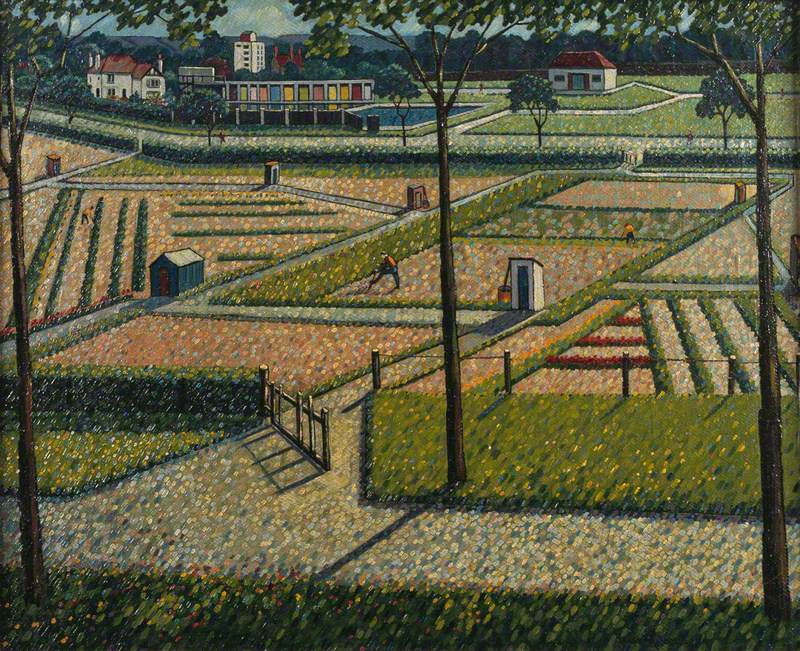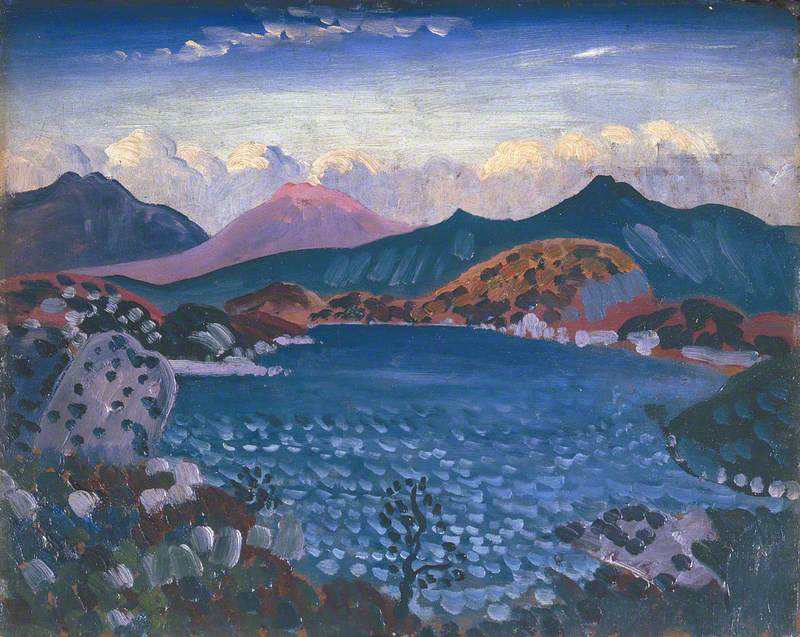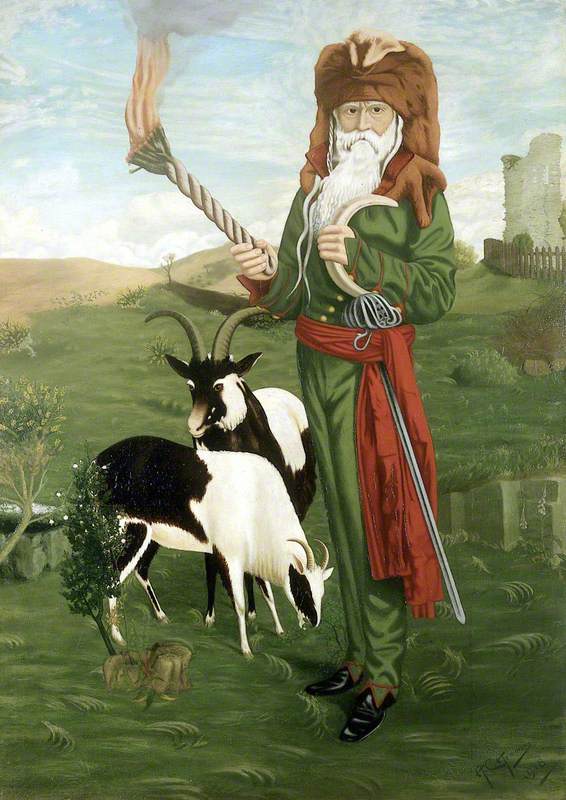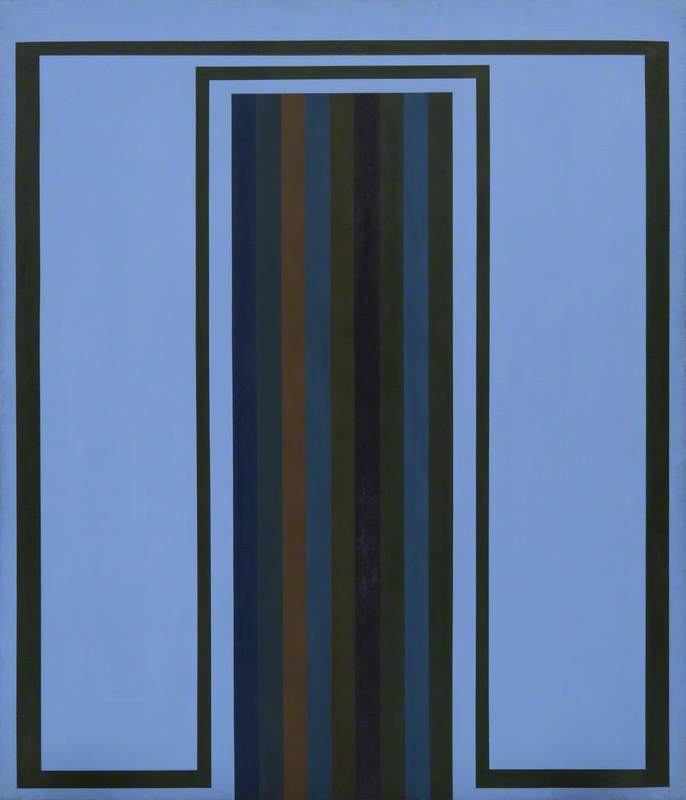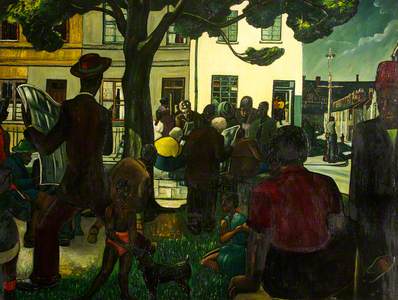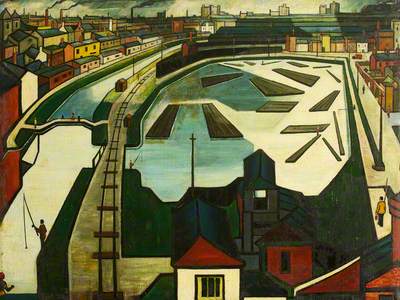'Forget what others have done and do what you want to do – that's the best advice I'd give' – Charles Byrd
Before his death in 2018, aged 101, Charles Byrd spent decades creating kinetic sculptures, his colourful 'magical machines', which fascinated children and adults alike. But first, Byrd painted the city of Cardiff, becoming perhaps its finest chronicler in the 1950s and early 1960s, a period in which it went through significant changes. Despite this, to most across south Wales and beyond, he remains an obscure figure.
Railway Crossing with a Cyclist, Fisherman and Other Figures
Charles Byrd (1916–2018) 
In his paintings, free of ego or artifice, Byrd showed only passing interest in the city's castles and grand civic buildings, preferring the docklands, markets, backyards, parks and fields; industrial, rural and social spaces.
Dedicated entirely to his work, his sister Barbara described how Byrd died at over a century old with paint still on his hands, his small flat cluttered with the results of a lifetime's obsession. Born in Pontypridd and raised for a time in Barry, as an adult he made Cardiff his home: a place built on industry, the perfect foil for Byrd's early mission to capture the living, working city with his engineer's eye.
In the 1950s, as Byrd began to paint its many landscapes, Cardiff officially became the capital of Wales, cementing its position as the country's administrative centre. The city was reshaping itself for a new age, sped up in places by the smouldering damage of war. And as the famous Tiger Bay's roar began to dim, drowned out by the changing winds of industry, the multiracial communities of its own streets would be next to hear the crunch of the wrecking ball.
With only evening classes in terms of training, Byrd dedicated himself entirely to the artist's life in his early 30s, leaving far behind his army days and raft of former jobs (junior photographer, aircraft fitter, spectacle-maker), instead roaming the city and its surroundings, painting areas that soon would be razed to the ground and scenes recognisable to this day.
Byrd's period of painting representative, recognisable views was relatively short-lived, but prolific. In a 2016 interview, he told Cardiff Libraries 'I started painting when I came home from (service in) India in 1950. I painted all the Cardiff paintings in ten years, then I did five years of abstract painting and I turned to kinetic, moving art.'
Byrd would often study works of the great artists in books at the library, and his paintings show a clear knowledge of Impressionist and Post-Impressionist masters, evident in an elegant early painting of Gorsedd Gardens near the city's National Museum. This painting shows Byrd's use of a pointillist technique he would continue to employ, especially in nature settings, of overlaying base colours with tiny, regular dabs of brighter shades to suggest the play of light.
Some landscapes are more explicitly in debt to Cubism, but this too cannot fully account for his own burgeoning style which combined a draughtsman's careful geometry with, frequently, a notable sense of calm and tranquility.
Byrd's perspective is rarely gazing up in rapture at the heavens, or peering down from an ivory tower. His view is intrinsically working class. He painted wherever he could walk or cycle to, his perspective literally and figuratively at ground level, sometimes seeking out sightlines from a slight elevation to show ships in the docks, a flower seller in the market, or fields at the city's edge.
Speaking to Cardiff Libraries, Byrd discussed his technique: 'Most artists, they splash the colours onto the palette and they're mixing them – but you're likely to get muddy colours aren't you? No-one taught me this, but before I started painting, I'd mix, say, 5 shades of green, cold to warm, then pink through to bright red…. and I look at these paintings now and it's like they were painted yesterday.'
Central Market, Cardiff in particular is a riot of colour, a confection of flowers, fruits, coats and countertops that – especially when viewed in person at Newport Museum and Art Gallery – truly bursts off the canvas.
Coated with an unusually thick layer of varnish, it seems almost sticky, yet it also retains the shape and careful architecture of most of Byrd's work – notably the lines of the market counters zig-zagging their way front-to-back through the frame. A rare cluster of figures crowd the upper-right corner, the picture itself curiously narrow – over twice as high as it is wide – as if cropped to focus attention on the detail within.
Scenes crowded with people appear infrequently in his work, many untainted by the noise and bustle of human activity. Those famous Cardiff docks, by this time quieter than in their coal-powered heyday, seem largely absent of any workers. In Byrd's serene yet unsentimental scenes, it often feels like Sunday afternoon.
The works in his series 'Sophia Gardens, An Exhibition' show figures in greater numbers, buying tickets, relaxing on the grass – more popping up the longer you stare – with reds, blues and the yellow ochre he frequently returned to all appearing in small areas. The mood is enhanced by his pointillist detailing which dapples the foreground with light and shade, the overriding feeling one of contentment and quiet joy.
On top of creating a visual record of the docks and other changing, vanishing parts of the city, perhaps this is Byrd's greatest achievement: a feeling that reaches all the way out of childhood, something human, warm and true.
His sense of wonder and draughtsman's eye would go on to inform his colourful kinetic sculptures - like Valvo the Robot, now at Pontypridd Museum - and he would continue to work until the very last days of a long life. Those later years would see fewer works exhibited, but the same stubborn determination to create.
Local resident Linda Hicks remembers the artist well. Living just around the corner, she would often check on the elderly Charles, so engrossed in his work that some gentle encouragement to eat well or wash his paint-stained clothes was sometimes required.
'This is how artists live!' he would insist, waving at the mass of detritus, works-in-progress and decaying scraps. Ultimately, he was beholden to no one: never marrying, and never becoming part of the establishment. With little money but no constraints, he could simply do exactly as he pleased, pursuing his vision until the end.
Charles Byrd at his 100th birthday celebration in 2016
Today, you can walk into Charles Byrd's old local library and see his distinctive yellow ochre appearing in his neatly framed paintings – in a blouse on a washing line, a child's jacket, a parasol at the fair – and know that it was mixed ready on his palette, waiting to make the city live and breathe.
And now, it invites you to stop, and to breathe with it. Stay awhile.
Gordon Anderson, writer
With thanks to Linda Hicks, Cardiff Libraries, and Barbara and the staff of Newport Museum and Art Gallery for their help and kindness
This content was supported by Welsh Government funding
Further reading
Eisteddfod Genedlaethol Cymru, Charles Byrd, 2008
David Briers, The Charles Byrd Museum of Magical Machines, St David's Hall brochure, 1989
WIll Hayward, 'Charles Byrd: The charming life story of one of Wales' most prolific artists', Wales Online, 2018
Art UK Curations, Artists and places: Charles Byrd in Cardiff and Charles Byrd and his Magical Machines
Pontypridd Museum, 'Charles Byrd at 100'


















